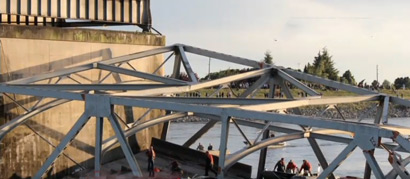
The four-lane bridge in Washington state that partially collapsed Thursday into the Skagit River was removed from Google Maps within a half day, according to reports, but it's the contributions and feedback from thousands of Map Maker users that allows Google to quickly
confirm changes and update the online content.
Initially, when the Map Maker user makes edits to a map, those changes may require review and approval before being published. Once a user makes
a few approved edits, most of the subsequent edits will go live automatically.
"A member of the community used the tool last night to make changes to the map very shortly after the collapse
occurred," said a Google spokesperson, midday Pacific Time. "We're working to update direction data, so people can get accurate directions that reroute them around the bridge. That update should be
live very soon."
The spokesperson said the community relies on local residents to make sure people get the most up-to-date changes.
That's a byproduct of the real-time Web, according
to Andrew Shotland, founder of Local SEO Guide. "In many ways, it's no different from finding out news on Twitter because there are enough people using it to touch someone in the local area," he said.
"There's probably a big enough community using the app that one of the first things they think about is updating Google Maps."
In 2010, Google Maps mistakenly uprooted the San Diego county city of La Jolla, Calif., and repositioned it in Orange County near the
Anaheim-Fullerton area. During the same year, Google also lost Sunrise, Fla.
Waze, founded in 2007,
became the topic of discussion Friday when rumors suggested that Google entered an acquisition bidding war with Facebook for the mobile mapping app that alerts users to potential traffic slowdowns or
suggests alternative routes to reach destinations. "The acquisition means it would keep the technology out of the hands out of competitors," Shotland said. "They would also gain the mobile
talent."
Similarly, Bing Maps tracks incidents and adjusts routing automatically after a road closure or other incident gets identified. "In the case of the Skagit Valley Bridge, within just a
few minutes, Bing Maps routed people around the bridge," according to a Bing spokesperson. "The map system also provides a 'report a problem' feature for specific local entities like restaurants,
movie theaters, grocery stores and more."